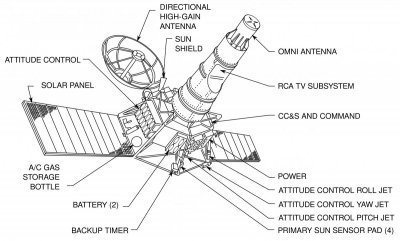Ranger 9 was a Lunar probe, launched in 1965 by NASA. It was designed to achieve a lunar impact trajectory and to transmit high-resolution photographs of the lunar surface during the final minutes of flight up to impact. The spacecraft carried six television vidicon camerastwo wide-angle (channel F, cameras A and B) and four narrow-angle (channel P)to accomplish these objectives. The cameras were arranged in two separate chains, or channels, each self-contained with separate power supplies, timers, and transmitters so as to afford the greatest reliability and probability of obtaining high-quality television pictures. These images were broadcast live on television to millions of viewers across the United States. No other experiments were carried on the spacecraft.
The Ranger program was a series of unmanned space missions by the United States in the 1960s whose objective was to obtain the first close-up images of the surface of the Moon. The Ranger spacecraft were designed to take images of the lunar surface, transmitting those images to Earth until the spacecraft were destroyed upon impact. A series of mishaps, however, led to the failure of the first six flights. At one point, the program was called "shoot and hope". Congress launched an investigation into "problems of management" at NASA Headquarters and Jet Propulsion Laboratory. After two reorganizations of the agencies, Ranger 7 successfully returned images in July 1964, followed by two more successful missions.
Ranger was originally designed, beginning in 1959, in three distinct phases, called "blocks". Each block had different mission objectives and progressively more advanced system design. The JPL mission designers planned multiple launches in each block, to maximize the engineering experience and scientific value of the mission and to assure at least one successful flight. Total research, development, launch, and support costs for the Ranger series of spacecraft (Rangers 1 through 9) was approximately $170 million (equivalent to $1.09 billion in 2020).

1965Mar, 21
Ranger program: NASA launches Ranger 9, the last in a series of unmanned lunar space probes.
Choose Another Date
Events on 1965
- 8Mar
Vietnam War
Thirty-five hundred United States Marines are the first American land combat forces committed during the Vietnam War. - 15Mar
Voting Rights Act
President Lyndon B. Johnson, responding to the Selma crisis, tells U.S. Congress "We shall overcome" while advocating the Voting Rights Act. - 6Aug
Voting Rights Act of 1965
US President Lyndon B. Johnson signs the Voting Rights Act of 1965 into law. - 27Nov
Lyndon B. Johnson
Vietnam War: The Pentagon tells U.S. President Lyndon B. Johnson that if planned operations are to succeed, the number of American troops in Vietnam has to be increased from 120,000 to 400,000. - 28Nov
Ferdinand Marcos
Vietnam War: In response to U.S. President Lyndon B. Johnson's call for "more flags" in Vietnam, Philippine President-elect Ferdinand Marcos announces he will send troops to help fight in South Vietnam.

 English
English  español
español  français
français  português
português  русский
русский  العربية
العربية  简体中文
简体中文 